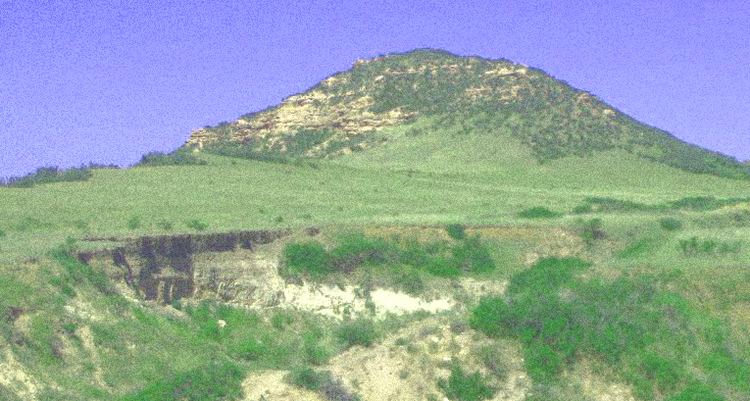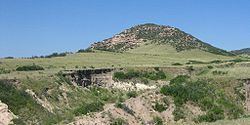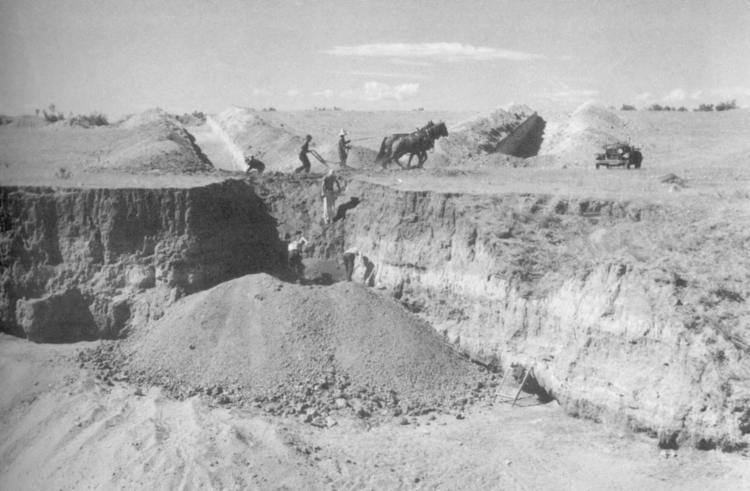NRHP Reference # 66000249 Area 73 ha Nearest city Fort Collins | Designated NHL January 20, 1961 Added to NRHP 15 October 1966 | |
 | ||
Lindenmeier symposium a folsom stone tube from the lindenmeier site
The Lindenmeier Site is a stratified multi-component archaeological site most famous for its Folsom component. It is located on the former Lindenmeier Ranch, now the Soapstone Prairie Natural Area, in northeastern Larimer County, Colorado, United States. The site contains the most extensive Folsom culture campsite yet found with a radiocarbon date of 10,600 to 10,720 B.P. Artifacts were also found from subsequent Archaic and Late pre-historic periods.
Contents
- Lindenmeier symposium a folsom stone tube from the lindenmeier site
- Lindenmeier site
- Paleo Indian period
- Post Folsom periods
- Artifacts by cultural period
- Coffin family
- Professional study
- Artifact collections
- Eiseleys Flight 857
- Soapstone Prairie Natural Area
- References

The site was declared a National Historic Landmark on January 20, 1961. The United States National Park Service has studied the possibility of making the Lindenmeier Site a United States National Monument.

Lindenmeier site
Paleo-Indian period
The period immediately preceding the first humans coming into Colorado was the Ice Age Summer starting about 16,000 years ago. For the next five thousand years the landscape would change dramatically and most of the large animals would become extinct. Receding and melting glaciers created the Plum and Monument Creeks, the Castle Rock mesas and unburied the Rocky Mountains. Large mammals, such as the mastodon, mammoth, camels, giant sloths, cheetah, bison antiquus and horses roamed the land.

There were a few Paleo-Indian cultures, distinctive by the size of the tools they used and the animals they hunted. People in the first, Clovis complex period, had large tools to hunt the megafauna animals of the early Paleo-Indian period.

With time, the climate warmed again and lakes and savannas receded. The land became drier, food became less abundant, and as a result the giant mammals became extinct. People adapted by hunting smaller mammals and gathering wild plants to supplement their diet. A new cultural complex was born, the Folsom tradition, with smaller projectile points to hunt smaller animals. Aside from hunting smaller mammals, people adapted by gathering wild plants to supplement their diet.
The Lindenmeier site, the largest known Paleo-Indian Folsom site, contained artifacts of the Paleo-Indians who lived and hunted in the present Fort Collins area approximately 11,000 years ago. Some of the artifacts are identified from people of the Folsom tradition, named for the Folsom Site in New Mexico, and identified as such by the Folsom points used for hunting the large, now extinct Bison antiquus. They likely also gathered food in the area, such as seeds, nuts and seasonal fruits. They were nomadic people, following the bison herds, and camping many places each year.
The tools and artifacts at the Lindenmeier site shed insight into the life of these Paleo-indians:
While bison were the mainstay of the hunter's diet, an ancient camel bone was found near a bison kill site. Being limited to one bone, it was likely carried from another area and did not necessarily indicate that the Folsom people hunted camel at Lindenmeier or at other sites.
Post-Folsom periods
The site has yielded evidence of occupation of the Lindenmeier site area over 13,000 years. While most of the artifacts were from the Folsom tradition, there are also artifacts gathered from post Folsom periods. Yuma points were also found on the site, were likely from a period a little later than the Folsom artifacts. Unfluted points were found on the Lindenmeier site from the Archaic and Late pre-historic periods and evidence of a late prehistoric kill site. The limited number of artifacts from this and other post-Folsom periods seem to indicate that the later people were more transitory than the people of the Folsom tradition or that there were limited resources in later years.
Artifacts by cultural period
Excavations resulted in the collection of tens of thousands of stone and bone artifacts. Artifacts were found from the Paleo-Indian, Archaic, and late Prehistoric periods.
Coffin family
Investigations of the Lindenmeier site and stone tools recovered from its location began in 1924 by the Coffin family.
The site was discovered in the summer of 1924 by A. Lynn Coffin, his father Judge Claude C. Coffin, and possibly Forest Service Ranger C. K. Collins. After the initial discovery, Major Roy G. Coffin also visited the site repeatedly with his brother the Judge and A. Lynn. They could not correlate the spear points that they found until Dr. E. B. Renaud from the Anthropology department at Denver University identified them as Folsom points found in 1926 at the Folsom Site in New Mexico. Excavation over 10 years generated an unprecedented collection of Folsom point artifacts and bison bones and stimulated interest at the United States Geological Society, Bureau of American Ethnology and many in the American Anthropology field. In 1937 Roy Coffin publishes Northern Colorado's First Settlers about the Coffin's work from 1924 to 1934. The site is named after William Lindenmeier, Jr., who was the landowner at the time of discovery and intensive investigations.
Professional study
Artifact collections
As of 2002, artifacts from the Lindenmeier site were held by:
Eiseley's Flight 857
As a young man, the writer Loren Eiseley participated in the early excavations at Lindenmeier. In his poem "Flight 857" from his book Notes of an Alchemist, he recorded his reflections on the significance of the Lindenmeier site finds:
Soapstone Prairie Natural Area
The City of Fort Collins purchased the site in 2004 as part of Soapstone Prairie Natural Area, which was opened to the public in 2009. The site is viewable from an overlook with interpretive signage.
